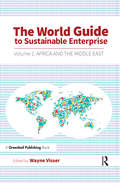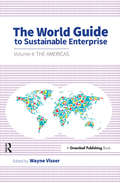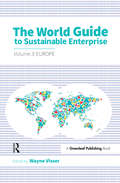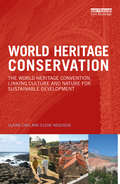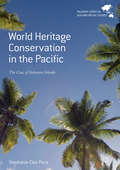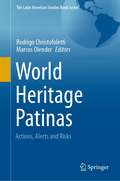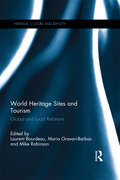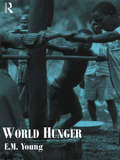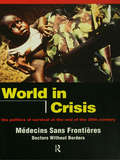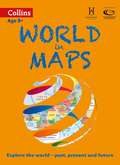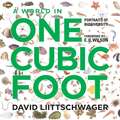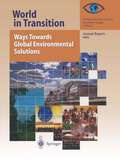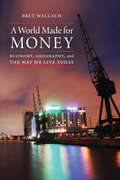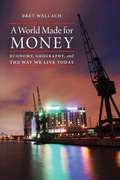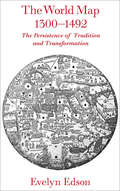- Table View
- List View
The World Guide to Sustainable Enterprise: Volume 1: Africa and Middle East
by Wayne VisserThe World Guide to Sustainable Enterprise is the first comprehensive global compendium that clearly describes the national approaches to sustainable enterprise. Through a systematic review of each country, this quick-to-access reference guide showcases the similarities and differences in each region. Every country profile includes key information about the relevant history, country-specific issues, trends, research, and the leading organizations operating in the field as well as best-practice case studies. The guide comprises four volumes, each dedicated to a specific region of the world. In a world where organizations are working increasingly across national and regional boundaries and research takes a joined-up and international approach, this book is an essential guide for practitioners and researchers in the disciplines of business sustainability, social enterprise and corporate responsibility. The first of its kind, this reference book provides the reader with a unique insight into what is the current state-of-play in each country. Each edited volume provides expert contributions from around the world; the contributors have been selected on the basis of their knowledge of the country and their clear experience in sustainable enterprise. Each regional/country profile includes the following subsections: Sustainable Enterprise in context; Priority issues; Trends; Government policies; Case studies; Further resources; and References. This unique resource will be an essential acquisition for all organizations who need to benchmark their sustainable enterprise strategies throughout different regions and cultures and want the best possible intelligence on the key issues and concerns relating to sustainable business and social responsibility in all of the markets in which they operate. It provides a useful companion reference collection to The World Guide to CSR, also edited by Wayne Visser. The full Four Volume Set of The World Guide to Sustainable Enterprise is available for purchase as a single item at a 25% discounted rate.
The World Guide to Sustainable Enterprise: Volume 4: the Americas
by Wayne VisserThe World Guide to Sustainable Enterprise is the first comprehensive global compendium that clearly describes the national approaches to sustainable enterprise. Through a systematic review of each country, this quick-to-access reference guide showcases the similarities and differences in each region. Every country profile includes key information about the relevant history, country-specific issues, trends, research, and the leading organizations operating in the field as well as best-practice case studies. The guide comprises four volumes, each dedicated to a specific region of the world. In a world where organizations are working increasingly across national and regional boundaries and research takes a joined-up and international approach, this book is an essential guide for practitioners and researchers in the disciplines of business sustainability, social enterprise and corporate responsibility. The first of its kind, this reference book provides the reader with a unique insight into what is the current state-of-play in each country. Each edited volume provides expert contributions from around the world; the contributors have been selected on the basis of their knowledge of the country and their clear experience in sustainable enterprise. Each regional/country profile includes the following subsections: Sustainable Enterprise in context; Priority issues; Trends; Government policies; Case studies; Further resources; and References. This unique resource will be an essential acquisition for all organizations who need to benchmark their sustainable enterprise strategies throughout different regions and cultures and want the best possible intelligence on the key issues and concerns relating to sustainable business and social responsibility in all of the markets in which they operate. It provides a useful companion reference collection to the World Guide to CSR, also edited by Wayne Visser. The full Four Volume Set of The World Guide to Sustainable Enterprise is available for purchase as a single item at a 25% discounted rate.
The World Guide to Sustainable Enterprise - Volume 3: Europe
by Wayne VisserThe World Guide to Sustainable Enterprise is the first comprehensive global compendium that clearly describes the national approaches to sustainable enterprise. Through a systematic review of each country, this quick-to-access reference guide showcases the similarities and differences in each region. Every country profile includes key information about the relevant history, country-specific issues, trends, research, and the leading organizations operating in the field as well as best-practice case studies. The guide comprises four volumes, each dedicated to a specific region of the world. In a world where organizations are working increasingly across national and regional boundaries and research takes a joined-up and international approach, this book is an essential guide for practitioners and researchers in the disciplines of business sustainability, social enterprise and corporate responsibility. The first of its kind, this reference book provides the reader with a unique insight into what is the current state-of-play in each country. Each edited volume provides expert contributions from around the world; the contributors have been selected on the basis of their knowledge of the country and their clear experience in sustainable enterprise. Each regional/country profile includes the following subsections: Sustainable Enterprise in context; Priority issues; Trends; Government policies; Case studies; Further resources; and References. This unique resource will be an essential acquisition for all organizations who need to benchmark their sustainable enterprise strategies throughout different regions and cultures and want the best possible intelligence on the key issues and concerns relating to sustainable business and social responsibility in all of the markets in which they operate. It provides a useful companion reference collection to the World Guide to CSR, also edited by Wayne Visser. The full Four Volume Set of The World Guide to Sustainable Enterprise is available for purchase as a single item at a 25% discounted rate.
The World Guide to Sustainable Enterprise - Volume 3: Europe
by Wayne VisserThe World Guide to Sustainable Enterprise is the first comprehensive global compendium that clearly describes the national approaches to sustainable enterprise. Through a systematic review of each country, this quick-to-access reference guide showcases the similarities and differences in each region. Every country profile includes key information about the relevant history, country-specific issues, trends, research, and the leading organizations operating in the field as well as best-practice case studies. The guide comprises four volumes, each dedicated to a specific region of the world. In a world where organizations are working increasingly across national and regional boundaries and research takes a joined-up and international approach, this book is an essential guide for practitioners and researchers in the disciplines of business sustainability, social enterprise and corporate responsibility. The first of its kind, this reference book provides the reader with a unique insight into what is the current state-of-play in each country. Each edited volume provides expert contributions from around the world; the contributors have been selected on the basis of their knowledge of the country and their clear experience in sustainable enterprise. Each regional/country profile includes the following subsections: Sustainable Enterprise in context; Priority issues; Trends; Government policies; Case studies; Further resources; and References. This unique resource will be an essential acquisition for all organizations who need to benchmark their sustainable enterprise strategies throughout different regions and cultures and want the best possible intelligence on the key issues and concerns relating to sustainable business and social responsibility in all of the markets in which they operate. It provides a useful companion reference collection to the World Guide to CSR, also edited by Wayne Visser. The full Four Volume Set of The World Guide to Sustainable Enterprise is available for purchase as a single item at a 25% discounted rate.
World Heritage Conservation: The World Heritage Convention, Linking Culture and Nature for Sustainable Development
by Claire Cave Elene NegussieThe UNESCO World Heritage Convention has become one of the most successful UN instruments for promoting cultural diplomacy and dialogue on conservation of cultural and natural heritage. This book provides an overview of the convention through an interdisciplinary approach to conservation. It shows that based on the notion of outstanding universal value and international cooperation for the protection of heritage, the convention provides a platform for sustainable development through the conservation and management of heritage of significance to humanity. With increasing globalization of heritage, World Heritage Conservation is reviewed as an emerging interdisciplinary field of study creating new opportunities for inclusive heritage debate both locally and globally, requiring common tools and understanding. With over a thousand properties inscribed on the World Heritage List, from biologically diverse sites such as the Central Amazon Conservation Complex to the urban landscape of the metropolis of Rio de Janeiro, the book will help students, researchers and professionals in the identification, protection, conservation and presentation of World Heritage. Targeted at a diversity of disciplines, the book critically describes the strategies for implementing the convention and the processes of heritage governance for sustainable development.
World Heritage Conservation: The World Heritage Convention, Linking Culture and Nature for Sustainable Development
by Claire Cave Elene NegussieThe UNESCO World Heritage Convention has become one of the most successful UN instruments for promoting cultural diplomacy and dialogue on conservation of cultural and natural heritage. This book provides an overview of the convention through an interdisciplinary approach to conservation. It shows that based on the notion of outstanding universal value and international cooperation for the protection of heritage, the convention provides a platform for sustainable development through the conservation and management of heritage of significance to humanity. With increasing globalization of heritage, World Heritage Conservation is reviewed as an emerging interdisciplinary field of study creating new opportunities for inclusive heritage debate both locally and globally, requiring common tools and understanding. With over a thousand properties inscribed on the World Heritage List, from biologically diverse sites such as the Central Amazon Conservation Complex to the urban landscape of the metropolis of Rio de Janeiro, the book will help students, researchers and professionals in the identification, protection, conservation and presentation of World Heritage. Targeted at a diversity of disciplines, the book critically describes the strategies for implementing the convention and the processes of heritage governance for sustainable development.
World Heritage Conservation in the Pacific: The Case of Solomon Islands (Palgrave Series in Asia and Pacific Studies)
by Stephanie Clair PriceThis book explores the opportunities and challenges associated with the legal protection of World Heritage sites in the Pacific Islands. It argues that the small Pacific representation on the World Heritage List is in part due to a lack of strong legal frameworks for heritage conservation, putting such sites under threat. Providing a comprehensive analysis of the nomination, listing and protection of the Solomon Island World Heritage Site, it examines the implementation of the World Heritage Convention in the Pacific context. It explores how the international community’s broadening interpretation of the notion of ‘outstanding universal value’ has increased the potential for Pacific heritage to be classified as ‘World Heritage’. This book also analyses the protection regime established by the Convention, and the World Heritage Committee’s approach to heritage conservation, identifying challenges associated with the protection of Pacific Island heritage.
World Heritage Conservation in the Pacific: The Case of Solomon Islands (Palgrave Series in Asia and Pacific Studies)
by Stephanie Clair PriceThis book explores the opportunities and challenges associated with the legal protection of World Heritage sites in the Pacific Islands. It argues that the small Pacific representation on the World Heritage List is in part due to a lack of strong legal frameworks for heritage conservation, putting such sites under threat. Providing a comprehensive analysis of the nomination, listing and protection of the Solomon Island World Heritage Site, it examines the implementation of the World Heritage Convention in the Pacific context. It explores how the international community’s broadening interpretation of the notion of ‘outstanding universal value’ has increased the potential for Pacific heritage to be classified as ‘World Heritage’. This book also analyses the protection regime established by the Convention, and the World Heritage Committee’s approach to heritage conservation, identifying challenges associated with the protection of Pacific Island heritage.
World Heritage Patinas: Actions, Alerts and Risks (The Latin American Studies Book Series)
by Rodrigo Christofoletti Marcos OlenderThis book presents studies on the management of the Brazilian world heritage and its international counterparts, relating its preservationist practices to the risks and alerts that run its maintenance in the face of so many challenges in the contemporary world. The book has encouraged scholars from a wide variety of disciplines to contribute their valuable knowledge to research on the management and risks of Brazil's world heritage. It is a bold initiative that brings together contemporary studies on management, alerts and risks of the Brazilian world heritage and some international examples. It stands out not only for its interdisciplinary approach, but above all for compiling a wide range of approaches that analyze various dimensions of world heritage management. Unique experience in the management of world heritage allocated to Brazilian territory, this book was written by prominent academics and heritage management professionals and includes national and international case studies. It is a comprehensive academic book in Brazilian world heritage management literature and can therefore be used as an authoritative reference source as well as a significant teaching tool.
World Heritage Sites and Tourism: Global and Local Relations (Heritage, Culture and Identity)
by Laurent Bourdeau Maria Gravari-Barbas Mike RobinsonNot all World Heritage Sites have people living within or close by their boundaries, but many do. The designation of World Heritage status brings a new dimension to the functioning of local communities and particularly through tourism. Too many tourists accentuated by the World Heritage label, or in some cases not enough tourists, despite anticipation of increased numbers, can act to disrupt and disturb relations within a community and between communities. Either way, tourism can be seen as a form of activity that can generate interest and concern as it is played out within World Heritage Sites. But the relationships that World Heritage Sites and their consequent tourism share with communities are not just a function of the number of tourists. The relationships are complex and ever changing as the communities themselves change and are built upon long-standing and wider contextual factors that stretch beyond tourism. This volume, drawing upon a wide range of international cases relating to some 33 World Heritage Sites, reveals the multiple dimensions of the relations that exist between the sites and local communities. The designation of the sites can create, obscure and heighten the power relations between different parts of a community, between different communities and between the tourism and the heritage sector. Increasingly, the management of World Heritage is not only about the management of buildings and landscapes but about managing the communities that live and work in or near them.
World Heritage Sites and Tourism: Global and Local Relations (Heritage, Culture and Identity)
by Laurent Bourdeau Maria Gravari-Barbas Mike RobinsonNot all World Heritage Sites have people living within or close by their boundaries, but many do. The designation of World Heritage status brings a new dimension to the functioning of local communities and particularly through tourism. Too many tourists accentuated by the World Heritage label, or in some cases not enough tourists, despite anticipation of increased numbers, can act to disrupt and disturb relations within a community and between communities. Either way, tourism can be seen as a form of activity that can generate interest and concern as it is played out within World Heritage Sites. But the relationships that World Heritage Sites and their consequent tourism share with communities are not just a function of the number of tourists. The relationships are complex and ever changing as the communities themselves change and are built upon long-standing and wider contextual factors that stretch beyond tourism. This volume, drawing upon a wide range of international cases relating to some 33 World Heritage Sites, reveals the multiple dimensions of the relations that exist between the sites and local communities. The designation of the sites can create, obscure and heighten the power relations between different parts of a community, between different communities and between the tourism and the heritage sector. Increasingly, the management of World Heritage is not only about the management of buildings and landscapes but about managing the communities that live and work in or near them.
World Hunger
by Liz YoungWorld Hunger explores the nature and extent of contemporary world hunger, explaining why hunger still persists while agricultural production increases and genetic engineering revolutionises food production and distribution. Numerous case studies, drawn from the North and South, illustrate the diversity of diets in the world and the connections between the global and local. Globalisation and access to food in the global supermarket is examined.Explaining the essential political character of hunger, the author exposes popular myths and identifies positive changes where prevailing inequalities and ideologies are challenged and it becomes possible to envisage a world where hunger is history.
World Hunger
by Liz YoungWorld Hunger explores the nature and extent of contemporary world hunger, explaining why hunger still persists while agricultural production increases and genetic engineering revolutionises food production and distribution. Numerous case studies, drawn from the North and South, illustrate the diversity of diets in the world and the connections between the global and local. Globalisation and access to food in the global supermarket is examined.Explaining the essential political character of hunger, the author exposes popular myths and identifies positive changes where prevailing inequalities and ideologies are challenged and it becomes possible to envisage a world where hunger is history.
World in Crisis: Populations in Danger at the End of the 20th Century
by Médicins Sans Frontières/Doctors Without BordersThe tragedies of war, famine, disease and poverty continue to dominate our headlines. Faced with such tragedy, the politics, ethics, even the economics of humanitarian aid are becoming more complex. The role of relief agencies, the political will of the West, the reponsibilities of the international community for war crimes and human rights - these are all issues at the heart of contemporary humanitarian aid.World in Crisis - describing the plight of refugees and civilians caught up in war zones in both First and Third Worlds, the homeless, Gypsies, and AIDS/HIV groups in Europe and North America - highlights what can be done to alleviate human suffering in the future. The book concludes with reports from the frontline of the world's main conflict zones, in Bosnia, Liberia/Sierra Leone, Chechnya, Rwanda/Burundi and Sudan.Medecins Sans Frontieres/Doctors Without Borders is the world's largest independent organization for emergency medical aid. Through 25 years of action, the organization has become famous for bringing swift and direct aid to peoples affected by war and natural disaster, regardless of government consent.
World in Crisis: Populations in Danger at the End of the 20th Century
by Médicins Sans Frontières/Doctors Without BordersThe tragedies of war, famine, disease and poverty continue to dominate our headlines. Faced with such tragedy, the politics, ethics, even the economics of humanitarian aid are becoming more complex. The role of relief agencies, the political will of the West, the reponsibilities of the international community for war crimes and human rights - these are all issues at the heart of contemporary humanitarian aid.World in Crisis - describing the plight of refugees and civilians caught up in war zones in both First and Third Worlds, the homeless, Gypsies, and AIDS/HIV groups in Europe and North America - highlights what can be done to alleviate human suffering in the future. The book concludes with reports from the frontline of the world's main conflict zones, in Bosnia, Liberia/Sierra Leone, Chechnya, Rwanda/Burundi and Sudan.Medecins Sans Frontieres/Doctors Without Borders is the world's largest independent organization for emergency medical aid. Through 25 years of action, the organization has become famous for bringing swift and direct aid to peoples affected by war and natural disaster, regardless of government consent.
World In Maps (Collins Primary Atlases Series (PDF))
by Stephen ScoffhamCollins World in Maps is a multi-topic atlas of the world, which introduces the most relevant physical and human topics to reflect the Geography Key Stage 2-3 requirements of the National Curriculum. Formerly published as Collins Keystart World Atlas, this collection of maps can be used to investigate different themes and topics. It tells a story in maps, diagrams, charts, words and photographs, each of which presents information to compare and examine. We live on a remarkable planet and this atlas helps us to make sense of the world today and understand how things came to be, as well as how they might change in years to come. Suggested activities on each spread encourage users to explorer further.
A World in One Cubic Foot: Portraits of Biodiversity
by David LiittschwagerTwelve inches by twelve inches by twelve inches, the cubic foot is a relatively tiny unit of measure compared to the whole world. With every step, we disturb and move through cubic foot after cubic foot. But behold the cubic foot in nature—from coral reefs to cloud forests to tidal pools—even in that finite space you can see the multitude of creatures that make up a vibrant ecosystem. For A World in One Cubic Foot, esteemed nature photographer David Liittschwager took a bright green metal cube—measuring precisely one cubic foot—and set it in various ecosystems around the world, from Costa Rica to Central Park. Working with local scientists, he measured what moved through that small space in a period of twenty-four hours. He then photographed the cube’s setting and the plant, animal, and insect life inside it—anything visible to the naked eye. The result is a stunning portrait of the amazing diversity that can be found in ecosystems around the globe. Many organisms captured in Liittschwager’s photographs have rarely, if ever, been presented in their full splendor to the general reader, and the singular beauty of these images evocatively conveys the richness of life around us and the essential need for its conservation. The breathtaking images are accompanied by equally engaging essays that speak to both the landscapes and the worlds contained within them, from distinguished contributors such as Elizabeth Kolbert and Alan Huffman, in addition to an introduction by E. O. Wilson. After encountering this book, you will never look at the tiniest sliver of your own backyard or neighborhood park the same way; instead, you will be stunned by the unexpected variety of species found in an area so small. A World in One Cubic Foot puts the world accessibly in our hands and allows us to behold the magic of an ecosystem in miniature. Liittschwager’s awe-inspiring photographs take us to places both familiar and exotic and instill new awareness of the life that abounds all around.
World in Transition: Annual Report 1995 (World in Transition #1995)
by German Advisory Global change (WBGU)At the first Conference of the Parties of the Climate Convention in Berlin in Spring 1995 it became evident once again: To counteract anthropogenic climate changes, individuals as well as societies have to change their way of thinking and behavior. This accounts for other areas of global environmental change as well. Global trends like soil degradation, loss of biological diversity, water scarcity and population growth show little or no sign of improvement. In fact, in most areas a rapid deterioration has taken place. In its latest Report the German Advisory Council on Global Change describes "Ways Towards Global Environmental Solutions".
A World Made For Money: Economy, Geography, And The Way We Live Today
by Bret WallachA spirited and incisive survey of economic geography, A World Made for Money begins with the author stopped at a red light in Norman, Oklahoma. Observing the landscape of drugstores and banks, and for that matter the stoplight and roads themselves, Bret Wallach observes, "Everything I see has been built to make money" or, at the very least, to facilitate making money. This, he argues, is a global phenomenon that nonetheless has occurred only within the past hundred years or so. Although guidebooks and culture brokers often disparage these landscapes of commerce, Wallach--recipient of a MacArthur "genius grant"--argues that we would do well to pay them close attention. A World Made for Money provides a compelling, condensed tour of our world. From Silicon Valley to Sri Lanka, from post-Soviet Russia to post-apartheid South Africa, Wallach looks at how human beings are buying, manufacturing, working, growing and shipping food, and accessing the natural resources to fuel it all. These essential facets of daily life, propelled by the profit motive, represent a transnational force shaping our surroundings and environment in ways that may not always be beautiful (or even healthy) but that are fundamental to understanding how the world works in the twenty-first century. Wallach examines the relationship between acquisitiveness and landscape, reveals surprising contradictions and nuances, and provides fresh perspective on politically charged topics such as sprawl, deindustrialization, and agribusiness.
A World Made For Money: Economy, Geography, And The Way We Live Today (PDF)
by Bret WallachA spirited and incisive survey of economic geography, A World Made for Money begins with the author stopped at a red light in Norman, Oklahoma. Observing the landscape of drugstores and banks, and for that matter the stoplight and roads themselves, Bret Wallach observes, "Everything I see has been built to make money" or, at the very least, to facilitate making money. This, he argues, is a global phenomenon that nonetheless has occurred only within the past hundred years or so. Although guidebooks and culture brokers often disparage these landscapes of commerce, Wallach--recipient of a MacArthur "genius grant"--argues that we would do well to pay them close attention. A World Made for Money provides a compelling, condensed tour of our world. From Silicon Valley to Sri Lanka, from post-Soviet Russia to post-apartheid South Africa, Wallach looks at how human beings are buying, manufacturing, working, growing and shipping food, and accessing the natural resources to fuel it all. These essential facets of daily life, propelled by the profit motive, represent a transnational force shaping our surroundings and environment in ways that may not always be beautiful (or even healthy) but that are fundamental to understanding how the world works in the twenty-first century. Wallach examines the relationship between acquisitiveness and landscape, reveals surprising contradictions and nuances, and provides fresh perspective on politically charged topics such as sprawl, deindustrialization, and agribusiness.
The World Map, 1300–1492: The Persistence of Tradition and Transformation (Published in cooperation with the Center for American Places, Santa Fe, New Mexico, and Staunton, Virginia)
by Evelyn EdsonIn the two centuries before Columbus, mapmaking was transformed. The World Map, 1300–1492 investigates this important, transitional period of mapmaking. Beginning with a 1436 atlas of ten maps produced by Venetian Andrea Bianco, Evelyn Edson uses maps of the fourteenth and fifteenth centuries to examine how the discoveries of missionaries and merchants affected the content and configuration of world maps. She finds that both the makers and users of maps struggled with changes brought about by technological innovation—the compass, quadrant, and astrolabe—rediscovery of classical mapmaking approaches, and increased travel. To reconcile the tensions between the conservative and progressive worldviews, mapmakers used a careful blend of the old and the new to depict a world that was changing—and growing—before their eyes. This engaging and informative study reveals how the ingenuity, creativity, and adaptability of these craftsmen helped pave the way for an age of discovery.
World Map (Large Print)
by RnibThis is a map of the world. The map is framed by a dashed image border. There is a locator dot shown, which will be at the top left of the page when the image is the right way up. All land masses are textured (green) and sea areas are untextured (blue). On the left of the page are North and South America, in the centre Europe and Africa and to the right Asia and Australasia. Some areas have been given two-letter alphabetic labels due to space considerations. These are described in a key at the bottom left of the page.
World Map Showing Main Tectonic Plates (tactile)
by RnibThis is a tactile diagram for GCSE level students. It consists of three pages: The first page is a key with tactile symbols and labels explained, the second and third pages show a world map, with outlines of the main tectonic plates. Labels and arrows help the reader to navigate the image.
World map showing Tectonic Plates (contracted)
by RnibThis is a 2 page document containing a Key to the World Map of tectonic plates and a Map of the World showing the tectonic plates. Page One: Keys to world map of tectonic plates: This page has two keys to the world map of tectonic plates. The one on the left shows the two-letter abbreviations used on the map. The one on the right shows symbols, lines and textures (colour) with descriptive labels to the right. There is a locator dot shown, which will be at the top left of the page when the image is the right way up. Page Two: World map of tectonic plates: This is a map of the tectonic plates on the surface of the earth. There is a locator dot shown, which will be at the top left of the page when the image is the right way up. The map is framed by a dashed image border. All land masses are textured and sea areas are untextured. On the left of the page are North and South America, in the centre Europe and Africa and to the right Asia and Australasia. The boundaries of the tectonic plates are marked with a heavy line and their direction of movement indicated by arrows. Each plate is identified by a two-letter abbreviation defined in the preceding key.
World map showing Tectonic Plates (large print)
by RnibThis is a 2 page document containing a Key to the World Map of tectonic plates and a Map of the World showing the tectonic plates. Page One: Keys to world map of tectonic plates: This page has two keys to the world map of tectonic plates. The one on the left shows the two-letter abbreviations used on the map. The one on the right shows symbols, lines and textures (colour) with descriptive labels to the right. There is a locator dot shown, which will be at the top left of the page when the image is the right way up. Page Two: World map of tectonic plates: This is a map of the tectonic plates on the surface of the earth. There is a locator dot shown, which will be at the top left of the page when the image is the right way up. The map is framed by a dashed image border. All land masses are textured and sea areas are untextured. On the left of the page are North and South America, in the centre Europe and Africa and to the right Asia and Australasia. The boundaries of the tectonic plates are marked with a heavy line and their direction of movement indicated by arrows. Each plate is identified by a two-letter abbreviation defined in the preceding key.
